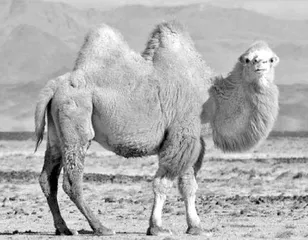Preserve a vanishing tradition among Gobi's camel herders戈壁牧民传统保卫战
作者: 涂丽平

蒙古的劝诱骆驼仪式是通过劝诱者的哄诱来加强母骆驼和小骆驼的关系。然而随着当地人生活方式的改变,这种仪式的传承已经受到威胁。
主题语境:牧民传统 篇幅:300词 建议用时:6分钟
1 Bactrian camels in the Gobiusually give birth to a baby camelevery second year. But because of theterrible weather conditions, it iscommon for a mother or baby to dieduring or after delivery. The result isoften lonely babies and sad motherswho need one another.
2 After centuries in the desert,the locals have developed a unique musical practice when they want a mother camel toaccept a newborn baby camel. When the practice starts, a musician plays his instrument,usually a Mongolian flute. The mother and baby are tied together, and another musicianbegins to sing,“ khuus, khuus, khuus.”
3 At first, the mother either pays no attention to the baby or treats it badly. The“ coaxer(劝诱者)”, at this point, changes the music based on the behavior. The singer begins tocopy the sound of the camels walking, running and voices. After many hours of this, themother and baby are in tears, and are joined for life.
4 However, each year fewer and fewer young people are willing to learn and pass on this tradition. In addition, more and more Mongolian families are sending daughters away tostudy and live in cities, and those who leave almost never return. The young men whoremain in the desert struggle then to find wives and raise families that can help raisecamels and keep the tradition alive. On top of that, many have discovered that motorbikesare cheaper than camels. All of these are killing the traditional way of life.
5 A few Mongolians have turned to the United Nations to help save this practice. In2015, they added it to their “List of Intangible Cultural Heritage in Need of UrgentSafeguarding”, but its hard to know what influence this can have beyond recognizing theexistence of the practice.
Reading Check
1. Why was the Mongolian practice developed?
A. To help baby camels get along with hosts.
B. To make mother camels give birth more often.
C. To calm down mother camels during delivery.
D. To strengthen mother and baby camels relationships.
2. What is special about the local practice mentioned in the text?
A. The locals feed the mother camel special food.
B. A musician plays a Mongolian flute to encourage bonding.
C. The locals dance around the mother and baby camel.
D. The baby camel is taken away from the mother.
3. What makes it difficult to keep the practice mentioned in the text alive?
A. Desertification and climate change.
B. Governments bans on the practice.
C. Young peoples lack of interest and urban migration.
D. Increased interest in camel racing instead of camel raising.
4. Whats the attitude of the author towards the practice?
A. Confident. B. Uncertain. C. Enthusiastic. D. Upset.
Language Study
Ⅰ. 日积月累
newborn adj. 新生的
instrument n. 乐器
behavior n. 行为
safeguard v. 保护
bactrian camel 双峰驼
terrible weather conditions 恶劣的天气条件
give birth to 生产;分娩
pay no attention to 不理会
be based on 基于
pass on 传递;传承
raise families 养家糊口
kill the traditional way of life 摧毁传统的生活方式
Ⅱ. 语法填空
In the Gobi, Bactrian 1.______ (camel) have calves every two years, but toughconditions often lead 2.______ deaths of mothers or babies. Locals have a tradition tohelp camels bond with orphaned calves 3.______ (use) music. A musician plays aMongolian flute, and another sings to mimic camel sounds, 4.______ eventually makesthe mother and calf connect 5.______ (emotional). This practice is dying 6.______ asfewer young people stay in the desert to maintain it. More families choose to send theirdaughters to cities for education and they seldom return, 7.______ (leave) fewer locals tocontinue the tradition. What's worse, motorbikes are replacing camels, further threateningthe practice. 8.______ (preserve) this cultural treasure, some Mongolians have soughthelp from the United Nations. Recognizing its cultural significance, it 9.______ (list) in2015 on the“ List of Intangible Cultural Heritage in Need of Urgent Safeguarding”, but it's unclear if this will be enough to influence the 10.______ (survive) of the tradition.